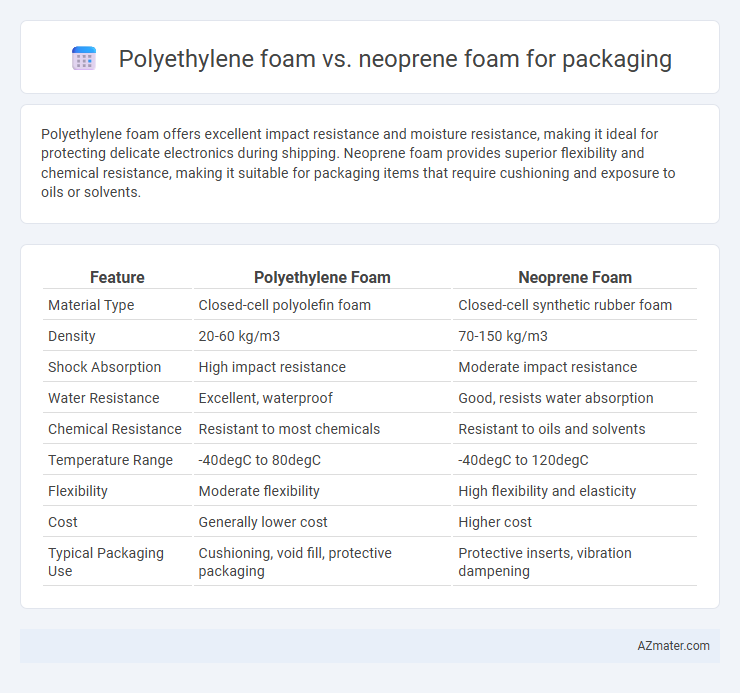Polyethylene foam offers excellent impact resistance and moisture resistance, making it ideal for protecting delicate electronics during shipping. Neoprene foam provides superior flexibility and chemical resistance, making it suitable for packaging items that require cushioning and exposure to oils or solvents.
Table of Comparison
| Feature | Polyethylene Foam | Neoprene Foam |
|---|---|---|
| Material Type | Closed-cell polyolefin foam | Closed-cell synthetic rubber foam |
| Density | 20-60 kg/m3 | 70-150 kg/m3 |
| Shock Absorption | High impact resistance | Moderate impact resistance |
| Water Resistance | Excellent, waterproof | Good, resists water absorption |
| Chemical Resistance | Resistant to most chemicals | Resistant to oils and solvents |
| Temperature Range | -40degC to 80degC | -40degC to 120degC |
| Flexibility | Moderate flexibility | High flexibility and elasticity |
| Cost | Generally lower cost | Higher cost |
| Typical Packaging Use | Cushioning, void fill, protective packaging | Protective inserts, vibration dampening |
Introduction to Packaging Foams
Polyethylene foam and neoprene foam are widely used packaging materials due to their excellent cushioning and shock absorption properties. Polyethylene foam is lightweight, closed-cell, and resistant to moisture, chemicals, and impact, making it ideal for protecting delicate electronics and industrial components. Neoprene foam offers superior resilience, temperature resistance, and flexibility, often preferred for packaging sensitive equipment requiring extra durability and environmental protection.
What is Polyethylene Foam?
Polyethylene foam is a closed-cell, lightweight material known for its excellent cushioning, impact resistance, and moisture barrier properties, making it ideal for packaging delicate items. It offers superior shock absorption and durability compared to neoprene foam, which is more flexible and often used for insulation rather than protective packaging. With its high resilience and resistance to chemicals and water, polyethylene foam provides enhanced protection during shipping and handling.
What is Neoprene Foam?
Neoprene foam is a synthetic rubber material known for its excellent resistance to heat, chemicals, and ozone, making it ideal for protective packaging. Its closed-cell structure provides superior cushioning, moisture resistance, and insulation compared to polyethylene foam. Neoprene foam's durability and flexibility protect delicate items during shipping and storage, especially in environments requiring temperature regulation.
Physical Properties Comparison
Polyethylene foam offers excellent impact resistance, low moisture absorption, and high chemical stability, making it ideal for lightweight packaging and cushioning fragile items. Neoprene foam excels in flexibility, durability, and resistance to oils, ozone, and varying temperatures, providing superior protection in dynamic or outdoor environments. Comparing density, polyethylene foam typically ranges from 20 to 120 kg/m3, while neoprene foam has a higher density around 200 to 500 kg/m3, resulting in distinct performance characteristics for specific packaging needs.
Cushioning and Shock Absorption
Polyethylene foam offers superior cushioning with high-density cells that provide excellent impact resistance and energy absorption, making it ideal for delicate packaging. Neoprene foam excels in shock absorption due to its closed-cell structure and elastic properties, effectively protecting against vibrations and repeated impacts. Both materials offer abrasion resistance, but polyethylene foam is preferred for lightweight cushioning, while neoprene stands out for durability and flexibility in dynamic shipping environments.
Water and Chemical Resistance
Polyethylene foam offers excellent water resistance due to its closed-cell structure, making it highly effective for packaging items exposed to moisture. Neoprene foam provides superior chemical resistance, protecting sensitive goods from oils, solvents, and other industrial chemicals. Choosing between them depends on whether water resistance or chemical exposure is the primary concern in packaging environments.
Durability and Longevity
Polyethylene foam offers excellent durability with high resistance to impact, moisture, and chemical exposure, making it ideal for long-term packaging protection. Neoprene foam provides superior flexibility and resilience against environmental stressors like heat and UV radiation, enhancing its longevity in dynamic packaging conditions. Both materials deliver robust cushioning, but polyethylene foam generally outperforms neoprene in terms of sustained structural integrity under heavy loads.
Environmental Impact
Polyethylene foam is lightweight, recyclable, and has a lower carbon footprint due to its efficient production processes, making it a more environmentally friendly option for packaging. Neoprene foam, derived from synthetic rubber, poses greater environmental concerns as it is non-biodegradable, harder to recycle, and involves more energy-intensive manufacturing. Choosing polyethylene foam helps reduce waste and supports sustainable packaging practices by minimizing environmental impact throughout the product lifecycle.
Cost-Effectiveness in Packaging
Polyethylene foam offers superior cost-effectiveness in packaging due to its lower material and production costs compared to neoprene foam, making it ideal for bulk applications. Its lightweight nature reduces shipping expenses, while still providing adequate cushioning and protection for a wide range of products. Neoprene foam, although more durable and resistant to chemicals, tends to incur higher costs that may not justify its use for standard packaging needs.
Best Applications for Each Foam
Polyethylene foam excels in packaging fragile electronics and heavy-duty equipment due to its high impact resistance and excellent cushioning properties. Neoprene foam offers superior chemical resistance and flexibility, making it ideal for packaging sensitive medical devices and products exposed to moisture or temperature fluctuations. Choosing polyethylene foam ensures durable protection against shocks, while neoprene foam provides enhanced moisture barrier and insulation for specialized packaging needs.

Infographic: Polyethylene foam vs Neoprene foam for Packaging
 azmater.com
azmater.com